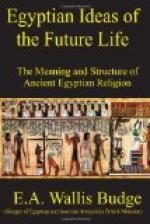passage which refers to the place in the eastern part
of heaven “where the gods give birth unto themselves,
where that to which they give birth is born, and where
they renew their youth,” it is said of this king,
“Teta standeth up in the form of the star...he
weigheth words (
or trieth deeds), and behold
God hearkeneth unto that which he saith.”
Elsewhere [Footnote: Ed. Maspero,
Pyramides
da Saqqarah, p. 111.] in the same text we read,
“Behold, Teta hath arrived in the height of
heaven, and the
henmemet beings have seen him;
the Semketet [Footnote: The morning boat of the
sun.] boat knoweth him, and it is Teta who saileth
it, and the M[=a]ntchet [Footnote: The evening
boat of the sun.] boat calleth unto him, and it is
Teta who bringeth it to a standstill. Teta hath
seen his body in the Semketet boat, he knoweth the
uraeus which is in the M[=a]ntchet boat, and God hath
called him in his name...and hath taken him in to
R[=a].” And again [Footnote:
Ibid.,
p. 150.] we have: “Thou hast received the
form (
or attribute) of God, and thou hast become
great therewith before the gods”; and of Pepi
I., who reigned about B.C. 3000, it is said, “This
Pepi is God, the son of God.” [Footnote:
Ibid., p. 222.] Now in these passages the allusion
is to the supreme Being in the next world, the Being
who has the power to invoke and to obtain a favourable
reception for the deceased king by R[=a], the Sun-god,
the type and symbol of God. It may, of course,
be urged that the word
neter here refers to
Osiris, but it is not customary to speak of this god
in such a way in the texts; and even if we admit that
it does, it only shows that the powers of God have
been attributed to Osiris, and that he was believed
to occupy the position in respect of R[=a] and the
deceased which the supreme Being himself occupied.
In the last two extracts given above we might read
“a god” instead of “God,”
but there is no object in the king receiving the form
or attribute of a nameless god; and unless Pepi becomes
the son of God; the honour which the writer of that
text intends to ascribe to the king becomes little
and even ridiculous.
Passing from religious texts to works containing moral
precepts, we find much light thrown upon the idea
of God by the writings of the early sages of Egypt.
First and foremost among these are the “Precepts
of Kaqemna” and the “Precepts of Ptah-hetep,”
works which were composed as far back as B.C. 3000.
The oldest copy of them which we possess is, unfortunately,
not older than B.C. 2500, but this fact in no way affects
our argument. These “precepts” are
intended to form a work of direction and guidance
for a young man in the performance of his duty towards
the society in which he lived and towards his God.
It is only fair to say that the reader will look in
vain in them for the advice which is found in writings
of a similar character composed at a later period;
but as a work intended to demonstrate the “whole
duty of man” to the youth of the time when the
Great Pyramid was still a new building, these “precepts”
are very remarkable. The idea of God held by Ptah-hetep
is illustrated by the following passages:—




